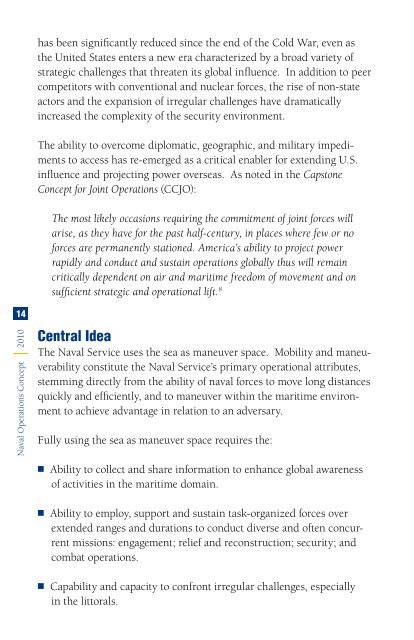Naval Operations Concept - Defense Technical Information Center
Naval Operations Concept - Defense Technical Information Center
Naval Operations Concept - Defense Technical Information Center
You also want an ePaper? Increase the reach of your titles
YUMPU automatically turns print PDFs into web optimized ePapers that Google loves.
<strong>Naval</strong> <strong>Operations</strong> <strong>Concept</strong> 2010<br />
has been significantly reduced since the end of the Cold War, even as<br />
the United States enters a new era characterized by a broad variety of<br />
strategic challenges that threaten its global influence. In addition to peer<br />
competitors with conventional and nuclear forces, the rise of non-state<br />
actors and the expansion of irregular challenges have dramatically<br />
increased the complexity of the security environment.<br />
The ability to overcome diplomatic, geographic, and military impediments<br />
to access has re-emerged as a critical enabler for extending U.S.<br />
influence and projecting power overseas. As noted in the Capstone<br />
<strong>Concept</strong> for Joint <strong>Operations</strong> (CCJO):<br />
The most likely occasions requiring the commitment of joint forces will<br />
arise, as they have for the past half-century, in places where few or no<br />
forces are permanently stationed. America’s ability to project power<br />
rapidly and conduct and sustain operations globally thus will remain<br />
critically dependent on air and maritime freedom of movement and on<br />
sufficient strategic and operational lift. 8<br />
Central Idea<br />
The <strong>Naval</strong> Service uses the sea as maneuver space. Mobility and maneuverability<br />
constitute the <strong>Naval</strong> Service’s primary operational attributes,<br />
stemming directly from the ability of naval forces to move long distances<br />
quickly and efficiently, and to maneuver within the maritime environment<br />
to achieve advantage in relation to an adversary.<br />
Fully using the sea as maneuver space requires the:<br />
n Ability to collect and share information to enhance global awareness<br />
of activities in the maritime domain.<br />
n Ability to employ, support and sustain task-organized forces over<br />
extended ranges and durations to conduct diverse and often concurrent<br />
missions: engagement; relief and reconstruction; security; and<br />
combat operations.<br />
n Capability and capacity to confront irregular challenges, especially<br />
in the littorals.

















